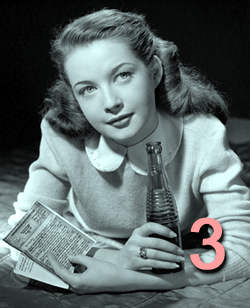Film, Radio and TV - 3 |
Sound and the Studio System
Sound Is Introduced Although by the mid-1920s technology had been developed for adding sound to films, the big studios were opposed to sound for several reasons:
The big studios stuck together for some time in discouraging the introduction of sound. However, one studio, Warner Brothers, was outside that group. Given the formidable competition from the other studios, they were struggling just to stay alive. Warner Brothers had nothing to lose by trying something daring. They reportedly didn't feel that sound would be more than a passing novelty; but, for as long as it lasted, they figured it might make them enough money to stay afloat. Sound was already being used in some theaters for Movietone news briefs, so at least these theaters were already equipped for sound.
The film consisted mostly of background music and contained only two segments with synchronized (lip-sync) sound--a total of only 354 spoken words--but that was enough to set off the sound revolution. Once the film captured public attention, people were lined up around the block from early morning until late at night to get tickets. |
Now, the major studios were worried. Recognizing a good thing, Warner Brothers rushed another film with Al Jolson into production. This one, The Singing Fool, was an even a bigger hit. It cost $200,000 to make and brought in $5 million. It must be said that the star, Al Jolson, a vaudeville performer, was perfect choice to launch sound. He had a natural talent for relating to audiences. Faced with the inevitable, the major studios reluctantly abandoned their stand against sound and started building their own sound stages. Within a few years almost all films were "talkies."
But, the move to sound was not without its consequences. Many stars couldn't make the transition, and left the business. Others quickly signed up for voice and diction lessons in an effort to try to save their careers. Even so, the studios used the special needs of sound as an excuse to get rid of some actors. Thousands of musicians who had provided the background music for films in local theaters were also thrown out of work. With sound, music needed to be recorded only once.
Hampered by the early limitations of sound equipment and the influx of sound technicians who were all but dictating how everything should be done, film production techniques took a giant step backward.
Early "talkies" used only one microphone and actors would have to surreptitiously move within its range before they could speak their lines. You often saw long scenes of dialogue such as the one shown here. Another major problem was that the camera had to be housed in a soundproof, telephone booth-like enclosure to keep the noise of the camera from being picked up by the microphone. This meant that the camera was virtually immobile; and since this was before the advent of zoom lenses, shots tended to be static and unimaginative. But, films had sound! For many people it was worth sacrificing production values to suddenly be able to hear actors speak. More on that in the next module. The Studio System By this time, the movie industry had clearly established three basic economic divisions: production (the making of the films), distribution (getting the films out to theaters) and exhibition (the actual screening of the films by theaters). After the NPPA guild was dissolved by government antitrust action, the studio heads gradually moved to another type of control--the studio system. The years between 1930 and 1950 are generally recognized as the studio years. MGM, 20th Century Fox, RKO, Warner Brothers, Paramount, Universal, and Columbia dominated these years. These studios created elaborate sound stages and developed hundreds of acres in Southern California land into back lot movie sets. During this era the studios developed a well-coordinated and efficient factory system for turning out films. In the studio system a major studio hired a stable of stars and production people to do as many films as they were assigned. These people were under contract and were not allowed to work for any other studio without permission. During this period, Warner Brothers became best known for its gangster films, MGM for its lavish star-studded musicals, and 20th Century Fox for its historical and adventure films.
An oligopoly is when a few companies control such a large part of an industry that the action of one affects all of the others. Although most of the studios were located in the Hollywood-Los Angeles area, they were managed through their New York business offices. New York CEOs--men like Louis B. Mayer and Darryl Zanuck-- controlled all of the major business decisions, right down to managing the lives of the actors that were in their films. In addition, these men and their companies controlled theater chains and the worldwide distribution of their films. Having shed the control of the MPPC, the film industry now found that it had fallen under the control of a few powerful studios. By this time, films had moved from the small 20- and 30-seat wooden-bench nickelodeon settings to large theaters--often very lavish theaters. During the boom years theaters were opening at the rate of one a week. Everyone, upper class and lower-class alike, regularly "went to the movies." At an average ticket price of 65-cents (35-cents before 6 p.m.), most everyone could afford to. For millions of Americans movies were entertainment, escape, and education all rolled into one.
This was the beginning of the golden age of Hollywood when the star system peaked. The big studios controlled most of the industry--and profits. Outsiders had little chance of successfully competing.
Early in this era, five major film stars rebelled against the block booking practice and four of them, Charlie Chaplin, Mary Pickford, Douglas Fairbanks and D.W. Griffith, formed their own production company--United Artists. Their company not only eliminated block booking, but also went on to produce many films that are considered classics. But, major troubles were on the horizon, as we'll see in the next module. |


 In 1927, in New York City, Warner Bros. introduced the first feature-length film featuring sound: The Jazz Singer, starring Al Jolson.
In 1927, in New York City, Warner Bros. introduced the first feature-length film featuring sound: The Jazz Singer, starring Al Jolson.  Many of the early sound films were not only crudely done, they were downright boring.
Many of the early sound films were not only crudely done, they were downright boring. 
 One technique for maintaining control was block booking, or requiring theaters to take scores of inexpensive, second-rate films with unknown stars in order to be able to show the few really good films. Theaters were sometimes required to sign up for 100 films or more, sight unseen.
One technique for maintaining control was block booking, or requiring theaters to take scores of inexpensive, second-rate films with unknown stars in order to be able to show the few really good films. Theaters were sometimes required to sign up for 100 films or more, sight unseen.